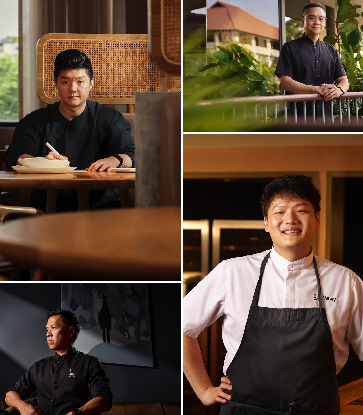Two-Michelin-starred Restaurant Andre is among the slate of restaurants to have been actively dusting its welcome mat to visiting luminaries. In June, chef Andre Chiang welcomed chef Dan Barber from Melbourne’s Brae restaurant and then in August, the restaurant played host to chef Albert Adria of Tickets and his brand of culinary theatre.
Those two are just the more recent efforts at collaborations. Last year, chef Chiang went on a world tour of 21 countries in conjunction with the launch of his book. That effort took him to countries as far apart as Copenhagen and Mexico.
The benefits for diners who experience the cuisine of a visiting chef are clear. “We’d like to introduce more restaurants to the Singapore clientele people from here may not get to visit or it’s actually hard to get there,” explains Chiang.

That’s all swell for the diners but what’s in it for a chef to travel so much, and what about the logistics of such a feat? We get the acclaimed chef to tell us more.
SEE ALSO: Chef Andre Chiang On The Art Of Fermented Juices
Let’s start. Firstly, why do you think chef collaborations are on the rise?
If you think about the last generation, no one ever cooks with other people. Everyone sees each other as a competitor. This generation, we see each other more as friends and peers and not competitors. We are willing to share our philosophy. Even the diners have changed. The last generation, you don’t see many people travelling for food but now we do.
The mentality of our customers have changed and so have the chefs. Now, we could cross over with someone who’s not even in the same category. I could work with Seiji Yamamoto from Ryugin, which is Japanese. I could cook with a Chinese chef, or Australian. I guess it’s an exchange where we share different philosophies. For us, we’re not doing this to promote ourselves or make profits. Actually not – we’re not making any profit out of this. It’s like an excuse to work with someone you admire. You admire his philosophy and then you thought it would be great to cook together.
It started when the economy was going down. A lot of restaurants cannot just survive by having only the local market as clientele. You see this overall in Europe or Japan or China – many of the countries’ economy have suffered and that goes hand in hand with the restaurant business. So people have to reach out. If you go to a Michelin-starred restaurant in France or elsewhere, you’ll see that half the diners are international customers. So if you don’t reach out and rely heavily on local guests, it’s not going to work.

Copenhagen, and Mexico. Yes it has definitely helped. Now, people travel for food and you’ll be able to speak to the audience in different zones. They might travel and stop over Singapore for two days before heading on to the next destination. All these 21 countries that we visited last year, a lot of customers come back to our restaurant. These guests come in and said, “Oh we heard you were in town but we couldn’t make it that day so we decided to fly over here.” You create a lot of clientele who travel to eat because they heard good things.
Is it difficult to procure ingredients in those countries?
For us, I’m pretty flexible. In fact, for most of the countries where we were travelling, I cooked different dishes. We try to do something attached to the city. When I was in Amsterdam I cooked a dish with jelly herring – because they eat herring and it was herring season. It becomes a unique dish for that event. We were in London, I was cooking a banoffee pie – that’s very British. You know, along the way you discover something and you want to create at least one or two dishes that belong to that place.
Do you conceive it before you arrive or after?
50/50. You can’t have a structure of what you’re going to do. It’s like going to the market, you already have a shopping list and once you get there, you see other things and what’s in season. You see two monkfish just off the boat, you’ll say, “I want to cook monkfish, instead of sardine.” It’s just like Restaurant Andre we don’t have a fixed menu. The only consistency that we have is freshness – we let our farmers and fishermen choose what’s best and then we adapt around it. If you try to stick to the same recipe and you’re not flexible then it’s really difficult overseas.










